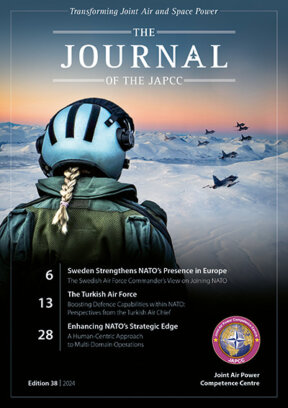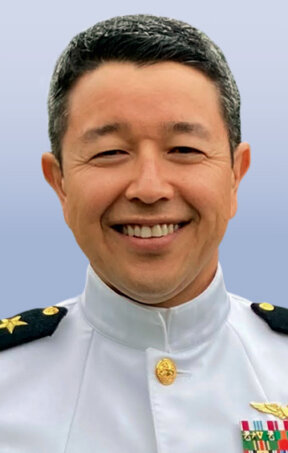‘Never fight unless you have to, never fight for long, and never fight alone.’
General Fox Conner, mentor of both Eisenhower and McArthur
As NATO considers how to conduct Multi-Domain Operations (MDO), the Alliance must consider interoperability across four dimensions: technical, procedural, informational, and human. Although technical capability and interoperability receive much attention, network-building technology cannot function without the requisite human and procedural dimensions of interoperability. Human interoperability requires trust built through shared experiences, like exercises, ultimately leading to decision advantage. This paper will describe and define interoperability, address why NATO needs a decision-making command and control network such as the US’s Combined Joint All Domain Command and Control (CJADC2), discuss CJADC2 across the four dimensions of interoperability, and conclude with recommendations of how and why all dimensions of CJADC2 interoperability could be addressed.
Never Fight Alone
This paper will focus on the implications of Conner’s advice to never fight alone on NATO. Although the US fought nearly all of its major expeditionary conflicts, from the Boxer Rebellion to Afghanistan, with allies and partners, interoperability remains a challenge.
In an alliance such as NATO, interoperability generally means all elements of military operations work together smoothly, which has been an area of effort since the organization’s foundation. On a strategic level, interoperability means the ability for Allies to act together coherently, effectively, and efficiently to achieve national and coalition objectives. On an operational level, NATO defines interoperability as enabling forces, units, and systems to operate together, allowing them to communicate and share common doctrine and procedures, along with each other’s infrastructure and bases. In other words, interoperability must encompass virtually every aspect of military activities and provide the option to ‘plug in’ allies and other partners. It is essential to ask why interoperability efforts still do not meet current requirements and what can be done to improve them, as interoperability challenges become more demanding.
CJADC2 Enables MDO for NATO
As the character of war rapidly changes and threats in the security environment evolve, NATO’s success in competition and armed conflict will depend upon optimizing effects from all domains. NATO developed and is refining the concept of MDO, which enables joint NATO forces to orchestrate military activities across all five operating domains. MDO, when realized, requires much greater data-driven agility than traditional joint operations. Leveraging data-advantage as an enabler, MDO synchronizes military effects with non-military operations, other national instruments of power, and the activities of NATO’s partners and stakeholders. Because NATO’s multifaceted concept of MDO requires synchronization, the command-and-control mechanism must be sophisticated, resilient, agile, and interoperable. The US’s solution is CJADC2, which will be a comprehensive network of all command-and-control systems. The US Department of Defense first conceived of the evolving Joint All-Domain Command and Control (JADC2) network in 2019 and tasked the US Air Force to lead implementation for US forces. Realizing the importance of integrating Allies and partner nations, the US renamed the concept the Combined Joint All-Domain Command and Control (CJADC2) in May 2023.
Integrating Allies and partners into CJADC2 network makes sense. A combined force is essential in competition or armed conflict against sophisticated adversaries such as the People’s Republic of China or Russia. According to an old proverb, ‘Who works alone adds, who works together multiplies.’ This sentiment aptly captures the necessity for NATO to work collaboratively. However, interoperability challenges rise as alliances garner more partners and assets. Although the network of systems cannot be a panacea for NATO’s challenges in competition and armed conflict, CJADC2 and its aspirational technology can be a solution to NATO’s need for C2 interoperability.
Interoperability means much more than just connectivity. CJADC2 architects seek to facilitate decision advantage by providing the right decision-maker with useful information. Vice Admiral (ret.) Ann Rondeau describes decision advantage in military operations as ‘the rapid discernment of trusted information for a decision-maker to act confidently – and first’. Useful information means that common form data moves from a relevant sender to the correct receiver (i.e., a decision maker or other actor) in the proper format. Connectivity, therefore, is a vital first step to sharing useful information. CJADC2 designers strive to connect sensors and data systems from NATO forces in a cloud architecture that uses Artificial Intelligence (AI) or automation to link the optimal weapons system to each target. While ambitious, the concept of networking existing C2 systems is feasible, although progress remains piecemeal. CJADC would link sensors, shooters, and decision-makers, to rapidly converge fires and then disperse for survival, much like the Uber ride-sharing application, where a machine learning algorithm optimizes the driver’s fares, rider routes, and many other factors. The most important takeaway is that CJADC2 will enable enhanced military decision-making; it is not a single product. Some aspects of CJADC2 will soon become operational, with others coming online in the next few years. Similarly, some NATO capabilities can integrate into the CJADC2 architecture sooner than others.
Robust interoperability is critical to implementing CJADC2 and can be described in many ways. US Joint Publication 1-02 (2010) defines interoperability as ‘the ability of systems, units, or forces to provide services to and accept services from other systems, units, or forces, and to use the services so exchanged to enable them to operate effectively together’. (Emphasis ours.)
Interoperability is the ability to provide military services from one nation to another. The end goal of CJADC2 is achieving decision advantage, where NATO forces make better decisions faster to achieve an operational advantage. CJADC2 will leverage human and AI decision-makers, often called human-machine teaming, and will favor either the human or automation depending on a bevy of factors related to a decision’s context and authority level. Human-Machine Teaming (HMT) requires defined architectures and engineering that enable the timely exchange of appropriate information to facilitate both human and machine decision-making. Given the importance of decision advantage, the four interoperability dimensions of CJADC2 are worth examining.
Technical Dimension of CJADC2 Interoperability
CJADC2 requires technical interoperability with NATO Allies’ disparate systems to communicate with each other. Conceptually, a multinational, joint task force that achieves unity of effort can be understood as cooperation and collaboration among autonomously operating systems, a System of Systems (SoS). These SoS have four main characteristics: autonomy, belonging, connectivity, and heterogeneity. The heterogeneity of SoS, meaning that constituent systems employ different technologies and software interfaces, creates challenges. Data standards (discussed later) and software are two key components that allow systems to ‘plug in’ to the network architecture.
Software must be backward compatible and able to translate to older systems in the field. Novel technology like multi-static arrays, which use several overlapping transmission and receiver sensor nodes across a battlespace, can increase situational awareness and agility on the battlefield. If multi-static arrays become commonplace among NATO sensor systems, they will facilitate faster and more efficient targeting. For instance, compatible, multi-static radar networks will allow for more rapid, precise localization of objects – adversary or otherwise. Similarly, multi-static sonar systems allow for speedier triangulation undersea.
Therefore, systems must be acquired with technological interoperability built-in and ideally designed for quick removal and replacement to facilitate software and hardware upgrades. Further, electromagnetic compatibility must be a consideration when purchasing systems. When transmission capabilities and antennas of NATO sensor systems are designed with the same DNA (frequency, encryption, programming languages, and human interfaces), such multi-static sensing and communication have the potential to empower sensor-to-shooter interoperability and could aid MDO. Emerging technical solutions like Edge AI, which computes at each network node, can aid tools such as agile frequency hopping to ensure radio transmission can connect sensors, shooters, and decision-makers. Getting these advanced technologies into the hands of warfighters requires considerable collaborative efforts in developing and purchasing enabling command and control systems. NATO must consider how it wishes to leverage the potential of AI, enabling computing in individual platforms and speeding up the OODA (Observe-Orient-Decide-Act) loop. However, in so doing, AI data streams must be digestible by all AI-enabled platforms. These AI-capable platforms must also be technically interoperable with legacy NATO platforms to share ‘sensor-to-shooter’ computations. This means dynamically establishing interoperability between various heterogeneous cyber-physical systems, which is enormously challenging. Ideally, this should be solved by a common development of architecture, software data stacks, and open upgradeable system solutions within acquisition strategies.
Since its founding, NATO has been an accelerator for human interoperability through standardization and joint exercises. The yearly NATO Coalition Warrior Interoperability eXploration, eXperimentation, eXamination eXercise (CWIX) combines all four dimensions, focusing on human and technical interoperability.
This event is a testbed oriented on the requirements specified by Federated Mission Networking (FMN) Spirals. FMN is how affiliates come together to achieve a standard level of interoperability. NATO members have vastly different requirements, both in technology, operational principles and training. In a federation, one’s own networks and systems are maintained and coordinated under the umbrella of FMN. In a federated manner, NATO nations can coordinate actions together without giving up national independence. NATO, therefore, speaks of day zero interoperability. The likelihood of achieving day zero interoperability increases by using ‘spiral development’. Spirals, defined periods with a specified degree of interoperability, provide waypoints for FMN development in events like CWIX.
While FMN illustrates technological changes, how humans respond to differing technology matters and ultimately defines the level of human interoperability necessary with a machine. Despite creating advanced autonomous machines, humans must never give total control to the algorithms as we create automated systems. In the context of connecting a massive, allied military architecture, this means NATO must adapt to the evolving relationships between human operators and automated machines.
Procedural Dimension of CJADC2 Interoperability
Aligning language, processes, procedures, and products is a precondition to making the technological solutions work together seamlessly. The NATO Standardization Office (NSO) is responsible for developing common standards and ways of working together. This is mainly done through Standardization Agreements. The sheer number of such agreements – their official website lists 1149 – gives an idea of the challenge.
Despite the challenges, cross-domain solutions for sensing and targeting are necessary against a near-peer adversary. Developing the federated requirements and doctrinal procedures for air assets using cyberspace fires, maritime Intelligence, Surveillance, and Reconnaissance (ISR), or fires coming from the land domain requires coordinated doctrine and Tactics, Techniques, and Procedures (TTP) by all services. One way to develop doctrine and TTP is through robust simulations and exercises.
NATO’s simulations, exercises, and iterative design are exponentially more valuable when lessons are learned and procedures are written down. For instance, NATO’s Command and Control Simulation Systems Interoperation (C2SIM) demonstrates how to elevate operator proficiency of C2 software and procedures among nations, as new technologies emerge.
Human Dimension of CJADC2 Interoperability
Human factors play a crucial role in achieving interoperability, which involves interaction between individuals, teams, and their technologies or systems. The human and procedural aspects of interoperability are closely linked. In strategic organizations like NATO, humans make choices and codify them in policies that increase interoperability. Central to interoperability efforts in the Alliance are the willingness and ability of leaders to communicate and collaborate. Interoperability is much more than the capability to exchange data; disparate human systems across nations and HQs must also be aligned.
Therefore, a common lexicon, common symbology, and procedures are just the beginning. Humans take data and assign meaning to it to make the information useful. Useful information can be applied to become knowledge and develop understanding. From this understanding of what one does alongside a fellow warfighter and what the fellow warfighter will do in turn, we begin to form innately human bonds of trust. Trust comes from serving together, drilling together, and putting your life into another servicemember’s hands. This is why NATO must continuously train together.
Information Dimension of CJADC2 Interoperability
The information dimension of interoperability refers to data integrity, standards, and conduits that carry and compile the data. Language, syntax, and transmission means are all part of the information dimension. The information dimension is essential because humans assign meaning to data in context and make decisions based on this information. Given the volume of information humans must digest in MDO, CJADC2 should employ computational aids. AI, particularly machine learning, can aid humans in making decisions.
There are three requirements to use machine learning: computing power, trained algorithms, and interoperable data. AI programmers spend excessive time data wrangling to ensure data are interoperable. NATO should continue to develop practical data standards for AI and machine learning applications. Data standards ensure that the format, lexicon, and measurements of different NATO platforms from various NATO nations share compatible data. When the data are wrangled (or groomed) before proceeding the AI tool is more likely to produce meaningful results. Neural networks examine many factors to classify data. When the data are standardized, the algorithms can be trained through supervised learning to yield better predictive models, like those used by Uber. In essence, without groomed data, machine learning functionality will be limited at best or woefully incorrect at worst. The NSO could contribute meaningfully to data standardization efforts. Similarly, NATO will need to develop a robust data repository where data can be shared. Additionally, programmers must think through how to best compartmentalize information in the cloud. For example, despite reducing operational effectiveness, some information may not be shared due to a NATO member’s national caveats. Therefore, cloud storage will require some data to go through ‘gates’ and other data to flow freely among Alliance platforms. Thinking through these restrictions requires a partnership between programmers and military experts who can technically and procedurally ensure the protection of information. As CJADC2 becomes operational, the importance of informational interoperability cannot be understated.
CJADC2 Requires Technical and Human Interoperability
‘Interoperability is often considered to be a desired but unattainable goal rather than a condition that can be quantified.’ One way to frame successful interoperability is to minimize missed opportunities. As CJADC2 begins to link networks, we should emphasize both the technological and human dimensions of interoperability.
As the character of war rapidly evolves, NATO nations must seek collaboration with each other and with their industries. If countries and their industries share algorithms, leverage standardized and translatable datasets, and compatible, upgradable equipment, NATO will benefit from technological and informational interoperability efforts. The ‘evolving construct’ of CJADC2 has achieved its minimum viable capability, meaning that NATO could use CJADC2 and update it for the Alliance. Likewise, NATO’s FMN is proving that technical interoperability can happen. Beyond the information sharing that FMN portends, NATO must ensure that the right information, in the right format, gets to the right user to allow for decision advantage. Technology alone as an enabler for MDO cannot be the solution. As NATO Allied Command Transformation Strategic Foresight 2023 notes, ‘Potential adversaries will also seek to erode NATO’s technological edge by seeking dominance in non-traditional technological areas.’ Therefore, beyond technical interoperability, NATO forces must build resilience by integrating into the CJADC2 network through sound procedures and human aspects, such as education, training, and adopting a common lexicon. Doing so will forge trust, the ‘secret sauce’ of human interoperability.
As such, it is the human aspect that NATO must focus on. NATO members must continue to train together and think deeply together. Our shared values and experiences since 1949 continue to be one of our strengths, and human interoperability cannot be lost. Successful interoperability – synchronizing the Alliance’s actions in time, space, purpose, and information that provides decision advantage – will prove critical to NATO, ensuring that MDO and the requisite CJADC2 architecture are not a series of buzzwords, but an emerging reality.













